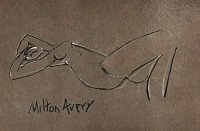BIOGRAPHY

Milton Avery, American (1885-1965)
Known as a colorist focused on serene mood, harmony, and rounded shapes, Milton Avery was primarily a self-taught painter whose work combining abstraction and realism suggests dialogue between line, shape, muted color, and subdued emotions. Most of his subjects were either marine scenes or figure studies.
Although never associated with a particular movement, Avery was a key modernist who influenced succeeding generations of artists including Color Field painters Mark Rothko and Adolph Gottlieb.
Born in Altmar, New York, Avery studied art in Hartford at the Connecticut League of Art Students before settling in New York City in 1925.
1944 was a watershed year for Avery, largely because of a new gallery association with Paul Rosenberg in New York. Rosenberg had fled to New York from Europe with both a strong interest and inventory of avant-garde paintings, which he wanted to enhance. In addition to this collection, he agreed to buy twenty-five of Avery's paintings twice a year, which meant that Avery did not have to worry about money and could focus on being creative.
With this new freedom, he became much more prolific, and his style changed from a brushy, painterly application and graphic detailing to denser, more even areas of flattened color within delineated forms.
As his career continued, he became more and more focused on concentrated color within simple, broadly contoured shapes. He perfected the technique of applying thin washes of paint to create veiled fields of color.
In January, 1949, he had an heart attack that left him physically weak for the remainder of his life, and he died in 1965, having suffered a second heart attack three years earlier.
Sources include:
Matthew Baigell, Dictionary of American Art
Michael David Zellman, 300 Years of American Art
